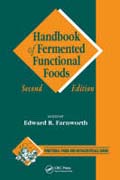
Following the lead of the original, this new edition of the "Handbook of Fermented Functional Foods" is written by international experts in the forefront of fermented food science and technology. Completely updated to reflect the amazing progress being made in the field of probiotics, this new edition also adds several new chapters on fermented foods from China, Thailand, and India. Each chapter is structured to highlight how the fermentation process results in acomposition with positive effects on human metabolism and health. It covers those foods commonly known to the western world, as well as fermented foods with long traditions in Eastern Europe, Asia, and Africa. INDICE: The History of Feremented Foods. Challenges Associated with the Development of Probiotic-Containing Functional Foods. The Properties of Enterococcus faecium and the Fermented Milk Product- Gaio(R). Kefir--A Fermented Milk Product. Yogurt and Immunity: The Health Benefits of Fermented Milk Products That Contain Lactic Acid Bacteria. Health Properties of Milk Fermented with Lactobacillus. Casei strain Shirota (LcS).Biologically Active Peptides Released in Fermented Milk: Role and Functions. Cheese and Its Potential As a Probiotic Food. Natto: A Soybean Food Made by Fermenting Cooked Soybeans with Bacillus subtilis (natto). Fermented Meat. Miso: Production, Properties, and Benefits toHealth. Korean Fermented Foods: Kimchi and Doenjang. Lactobacillus plantarum:The Role in Foods and in Human mHealth. Sauerkraut. New Trends of Table OliveProcessing for Quality Control and Functional Proprieties. Traditional Chinese Fermented Foods. Tempeh: A Mold-Modified Indigenous Fermented Food. Thai Fermented Foods: Microorganisms and Their Health Benefits. Production of Probiotic Cultures and Their Addition in Fermented Foods. The Future for Fermented Foods. Index.
- ISBN: 978-1-4200-5326-5
- Editorial: CRC Press
- Encuadernacion: Cartoné
- Páginas: 600
- Fecha Publicación: 01/06/2008
- Nº Volúmenes: 1
- Idioma: Inglés
